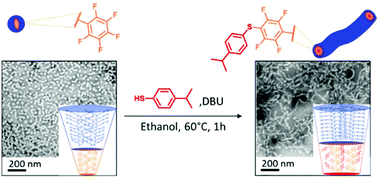Sphere-to-worm morphological transitions and size changes through thiol–para-fluoro core modification of PISA-made nano-objects†
Abstract
Postpolymerization modification is a powerful strategy to change the chemical functionality of pre-made polymers, but only limited approaches exist to modify functionality as well as the shape and behaviour of nano-particles. Herein, poly[poly(ethylene glycol) methyl ether methacrylate]-poly(2,3,4,5,6-pentafluorobenzyl methacrylate) nano-objects (pPEGMA-pPFBMA) prepared via RAFT dispersion polymerization with concurrent polymerization-induced self-assembly (PISA) in ethanol with either spherical or worm-shaped morphology were modified, post-synthesis, with a selection of 15 different thiols through thiol–para-fluoro substitution reactions in the nano-object cores. Depending on the choice of thiol, spherical nano-objects underwent an order–disorder transition to form unimers, increased in size, or underwent an order–order transition to form worm-shaped nano-objects. The core solvophobicity was found to be more important in driving a morphological transition than the modification efficiency, mass increase of the core block, or the glass transition temperature of the (partially) modified cores. These findings are relevant to the development of a “universal nanoparticle precursor” approach that allows the tuning of functionality, behaviour, size, and shape of a pre-made nano-object sample on demand.

- This article is part of the themed collection: Polymerization-Induced Self-Assembly (PISA)


 Please wait while we load your content...
Please wait while we load your content...